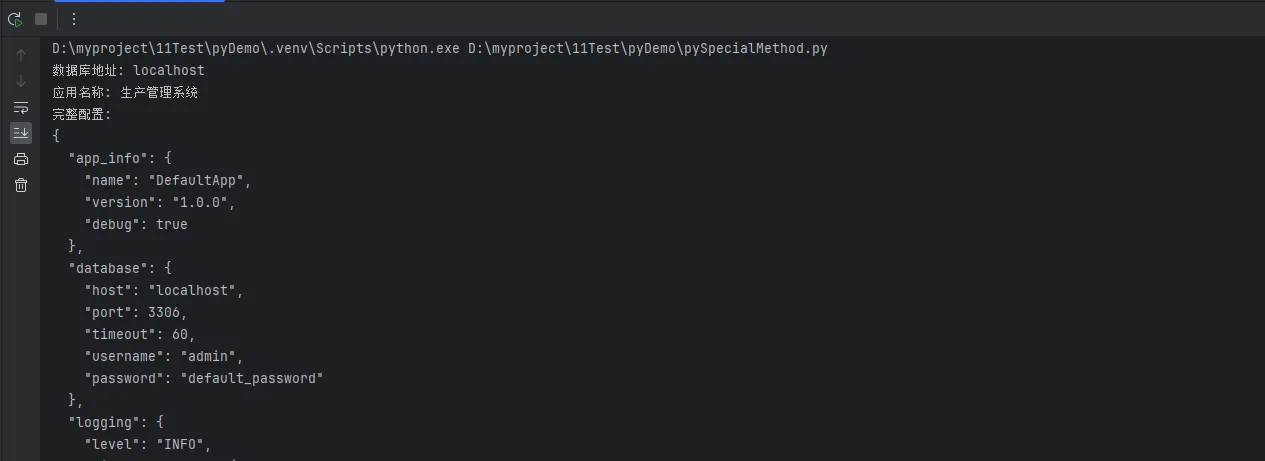目录
在Python面向对象编程中,你是否遇到过这样的困惑:为什么有些类可以直接用len()函数,有些却不行?为什么字符串可以用+连接,而自定义的类却报错?其实,这背后隐藏着Python的"魔法方法"(Special Methods),也叫双下划线方法(Dunder Methods)。
掌握魔法方法,就像给你的类装上了"超能力",让它们能够与Python的内置函数、操作符无缝配合。本文将带你深入了解Python魔法方法的实战应用,从基础概念到高级技巧,助你写出更加pythonic的代码。无论你是Python初学者还是有一定经验的开发者,都能在这里找到实用的编程技巧。
🤔 什么是魔法方法?为什么需要它们?
问题分析
在日常的Python开发中,我们经常会遇到这样的场景:
Python# 内置类型可以这样用
numbers = [1, 2, 3]
print(len(numbers)) # 3
print(str(numbers)) # '[1, 2, 3]'
# 但自定义类却不行
class Student:
def __init__(self, name, age):
self.name = name
self.age = age
student = Student("张三", 20)
print(len(student))

这就是魔法方法要解决的核心问题:让自定义类能够像内置类型一样,与Python的操作符和内置函数协同工作。
魔法方法的本质
魔法方法是Python类中以双下划线开头和结尾的特殊方法,如__init__、__str__、__len__等。它们定义了对象在特定情况下的行为:
__init__:对象初始化时调用__str__:调用str()或print()时调用__len__:调用len()时调用__add__:使用+操作符时调用
🔥 核心魔法方法实战解析
1️⃣ 字符串表示方法:__str__ 和 __repr__
这两个方法控制对象的字符串表示,但用途不同:
Pythonclass BankAccount:
def __init__(self, account_no, balance, owner):
self.account_no = account_no
self.balance = balance
self.owner = owner
def __str__(self):
"""用户友好的字符串表示 - 给用户看的"""
return f"{self.owner}的账户,余额:¥{self.balance:.2f}"
def __repr__(self):
"""开发者友好的字符串表示 - 给程序员看的"""
return f"BankAccount('{self.account_no}', {self.balance}, '{self.owner}')"
# 实战应用
account = BankAccount("6222123456789", 1000.50, "李四")
print(account)
print(repr(account))
# 在列表中显示时会调用__repr__
accounts = [account]
print(accounts)
 实用技巧:
实用技巧:
__str__:返回用户友好的描述__repr__:返回能重新创建对象的表达式,方便调试
2️⃣ 长度和容器方法:__len__、__getitem__、__setitem__
让你的类支持len()函数和索引访问:
Pythonclass StudentGrades:
def __init__(self, student_name):
self.student_name = student_name
self.grades = {} # 科目: 成绩
def add_grade(self, subject, score):
"""添加成绩"""
self.grades[subject] = score
def __len__(self):
"""支持len()函数"""
return len(self.grades)
def __getitem__(self, subject):
"""支持grades['数学']这样的访问"""
return self.grades.get(subject, "未参加考试")
def __setitem__(self, subject, score):
"""支持grades['数学'] = 95这样的赋值"""
self.grades[subject] = score
def __contains__(self, subject):
"""支持'数学' in grades这样的判断"""
return subject in self.grades
def __iter__(self):
"""支持for循环遍历"""
return iter(self.grades.items())
# 实战应用
grades = StudentGrades("王五")
grades.add_grade("数学", 95)
grades.add_grade("英语", 88)
print(len(grades)) # 2
print(grades["数学"]) # 95
grades["物理"] = 92 # 使用__setitem__
print("化学" in grades) # False,使用__contains__
# 遍历所有成绩
for subject, score in grades:
print(f"{subject}: {score}分")

3️⃣ 算术运算方法:让对象支持数学运算
Pythonclass Money:
def __init__(self, amount, currency="RMB"):
self.amount = amount
self.currency = currency
def __add__(self, other):
"""支持+运算"""
if isinstance(other, Money):
if self.currency != other.currency:
raise ValueError(f"货币类型不匹配: {self.currency} vs {other.currency}")
return Money(self.amount + other.amount, self.currency)
elif isinstance(other, (int, float)):
return Money(self.amount + other, self.currency)
return NotImplemented
def __sub__(self, other):
"""支持-运算"""
if isinstance(other, Money):
if self.currency != other.currency:
raise ValueError(f"货币类型不匹配: {self.currency} vs {other.currency}")
return Money(self.amount - other.amount, self.currency)
elif isinstance(other, (int, float)):
return Money(self.amount - other, self.currency)
return NotImplemented
def __mul__(self, other):
"""支持*运算(乘以倍数)"""
if isinstance(other, (int, float)):
return Money(self.amount * other, self.currency)
return NotImplemented
def __eq__(self, other):
"""支持==比较"""
if isinstance(other, Money):
return self.amount == other.amount and self.currency == other.currency
return False
def __lt__(self, other):
"""支持<比较"""
if isinstance(other, Money):
if self.currency != other.currency:
raise ValueError(f"货币类型不匹配: {self.currency} vs {other.currency}")
return self.amount < other.amount
return NotImplemented
def __str__(self):
return f"{self.amount:.2f} {self.currency}"
# 实战应用
price1 = Money(100.50)
price2 = Money(50.25)
total = price1 + price2 # Money(150.75, 'RMB')
discount = total - 20 # Money(130.75, 'RMB')
double_price = price1 * 2 # Money(201.0, 'RMB')
print(f"总价: {total}") # 总价: 150.75 RMB
print(f"折扣后: {discount}") # 折扣后: 130.75 RMB
print(price1 == price2) # False
print(price1 > price2) # True

4️⃣ 上下文管理器:__enter__ 和 __exit__
创建可以使用with语句的对象:
Pythonimport os
import time
class FileManager:
def __init__(self, filename, mode):
self.filename = filename
self.mode = mode
self.file = None
self.start_time = None
def __enter__(self):
"""进入with语句时调用"""
print(f"正在打开文件: {self.filename}")
self.start_time = time.time()
self.file = open(self.filename, self.mode, encoding='utf-8')
return self.file
def __exit__(self, exc_type, exc_value, traceback):
"""退出with语句时调用"""
if self.file:
self.file.close()
elapsed = time.time() - self.start_time
print(f"文件已关闭,用时: {elapsed:.3f}秒")
# 如果有异常发生
if exc_type:
print(f"处理文件时发生错误: {exc_value}")
return False # 不抑制异常
return True
# 实战应用
with FileManager("test.txt", "w") as f:
f.write("Hello, 魔法方法!")
f.write("Python开发真有趣!")

💼 实际项目中的高级应用
🎯 案例:创建一个智能配置管理器
在Windows下的上位机开发中,配置管理是常见需求。让我们用魔法方法创建一个强大的配置类:
Pythonimport json
import os
from pathlib import Path
class SmartConfig:
def __init__(self, config_file="config.json"):
self.config_file = Path(config_file)
self.data = {}
self.load_config()
def load_config(self):
"""加载配置文件"""
if self.config_file.exists():
try:
with open(self.config_file, 'r', encoding='utf-8') as f:
self.data = json.load(f)
except (json.JSONDecodeError, IOError) as e:
print(f"配置文件加载失败: {e}")
self.data = {}
def save_config(self):
"""保存配置文件"""
try:
with open(self.config_file, 'w', encoding='utf-8') as f:
json.dump(self.data, f, ensure_ascii=False, indent=2)
except IOError as e:
print(f"配置文件保存失败: {e}")
def __getitem__(self, key):
"""支持config['database.host']这样的访问"""
keys = key.split('.')
value = self.data
for k in keys:
if isinstance(value, dict) and k in value:
value = value[k]
else:
raise KeyError(f"配置项不存在: {key}")
return value
def __setitem__(self, key, value):
"""支持config['database.host'] = 'localhost'这样的设置"""
keys = key.split('.')
data = self.data
for k in keys[:-1]:
if k not in data:
data[k] = {}
data = data[k]
data[keys[-1]] = value
def __contains__(self, key):
"""支持'database.host' in config这样的判断"""
try:
self[key]
return True
except KeyError:
return False
def __enter__(self):
"""支持with语句,自动保存配置"""
return self
def __exit__(self, exc_type, exc_value, traceback):
"""退出时自动保存配置"""
self.save_config()
return False
def __str__(self):
return json.dumps(self.data, ensure_ascii=False, indent=2)
# 实战应用
with SmartConfig("app_config.json") as config:
# 设置数据库配置
config['database.host'] = 'localhost'
config['database.port'] = 3306
config['database.username'] = 'admin'
# 设置应用配置
config['app.name'] = '生产管理系统'
config['app.version'] = '1.0.0'
config['app.debug'] = True
# 检查配置项是否存在
if 'database.password' not in config:
config['database.password'] = 'default_password'
# 读取配置
print(f"数据库地址: {config['database.host']}")
print(f"应用名称: {config['app.name']}")
print("完整配置:")
print(config)
# 退出with语句时配置会自动保存到文件

🚀 性能优化与最佳实践
⚡ 避免常见陷阱
不要滥用**__getattr__和__getattribute__**
Python# ❌ 错误做法:会影响性能
class SlowClass:
def __getattr__(self, name):
# 每次访问不存在的属性都会触发,很慢
return f"未找到属性: {name}"
# ✅ 正确做法:明确定义需要的属性
class FastClass:
def __init__(self):
self.known_attrs = {'name', 'age', 'email'}
def __getattr__(self, name):
if name in self.known_attrs:
return f"默认_{name}"
raise AttributeError(f"'{type(self).__name__}' object has no attribute '{name}'")
合理使用**__slots__**节省内存
Python# 对于大量实例的类,使用__slots__可以节省内存
class OptimizedPoint:
__slots__ = ['x', 'y', 'z'] # 只允许这些属性
def __init__(self, x, y, z):
self.x = x
self.y = y
self.z = z
def __add__(self, other):
return OptimizedPoint(
self.x + other.x,
self.y + other.y,
self.z + other.z
)
🎪 魔法方法的组合应用
创建一个功能完整的数据容器类:
Pythonclass DataContainer:
def __init__(self, name):
self.name = name
self._data = []
# 基础魔法方法
def __len__(self):
return len(self._data)
def __bool__(self):
"""支持if container:这样的判断"""
return len(self._data) > 0
def __iter__(self):
return iter(self._data)
def __getitem__(self, index):
return self._data[index]
def __setitem__(self, index, value):
self._data[index] = value
def __delitem__(self, index):
del self._data[index]
# 比较方法
def __eq__(self, other):
if isinstance(other, DataContainer):
return self._data == other._data
return False
# 算术方法
def __add__(self, other):
"""合并两个容器"""
if isinstance(other, DataContainer):
result = DataContainer(f"{self.name}+{other.name}")
result._data = self._data + other._data
return result
return NotImplemented
# 上下文管理器
def __enter__(self):
print(f"开始操作容器: {self.name}")
return self
def __exit__(self, exc_type, exc_value, traceback):
print(f"操作完成,容器 {self.name} 现有 {len(self)} 个元素")
return False
# 字符串表示
def __str__(self):
return f"{self.name}: {self._data}"
def __repr__(self):
return f"DataContainer('{self.name}', {self._data})"
# 便捷方法
def append(self, item):
self._data.append(item)
def extend(self, items):
self._data.extend(items)
# 实战演示
with DataContainer("用户数据") as users:
users.append("张三")
users.append("李四")
users.extend(["王五", "赵六"])
print(f"用户数量: {len(users)}") # 4
print(f"第一个用户: {users[0]}") # 张三
# 遍历用户
for user in users:
print(f"用户: {user}")
# 合并容器
admins = DataContainer("管理员")
admins.append("管理员A")
all_users = users + admins
print(all_users)

💫 总结:掌握魔法方法的三个关键点
通过本文的深入学习,相信你已经对Python魔法方法有了全面的认识。让我们来总结一下三个核心要点:
1. 理解魔法方法的本质:魔法方法是Python实现"鸭子类型"的重要机制,它让自定义类能够无缝集成到Python的生态系统中。掌握了魔法方法,你就能写出更加pythonic和用户友好的代码。
2. 选择合适的魔法方法:不同的应用场景需要不同的魔法方法。数据容器类需要__len__、__getitem__等,数值计算类需要__add__、__mul__等,资源管理类需要__enter__、__exit__等。合理选择能让你的类功能更强大。
3. 性能和最佳实践:魔法方法虽然强大,但也要适度使用。避免在性能敏感的代码中滥用__getattr__,对于大量实例的类考虑使用__slots__,始终记住代码的可读性和维护性同样重要。
在Windows下的Python开发中,无论是上位机程序还是数据处理应用,魔法方法都能让你的代码更加优雅和强大。现在就在你的项目中试试这些技巧吧,让你的Python类真正"活"起来!
💡 延伸学习建议:深入学习Python面向对象编程的其他高级特性,如装饰器、元类等,它们与魔法方法结合使用能发挥更大的威力。关注我们的后续文章,持续提升你的Python开发技能!
本文作者:技术老小子
本文链接:
版权声明:本博客所有文章除特别声明外,均采用 BY-NC-SA 许可协议。转载请注明出处!